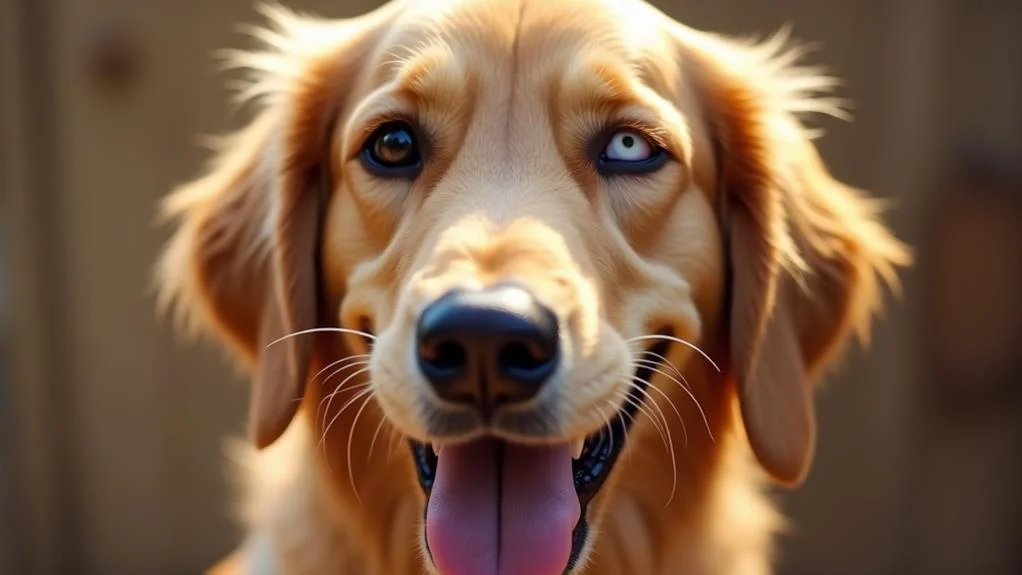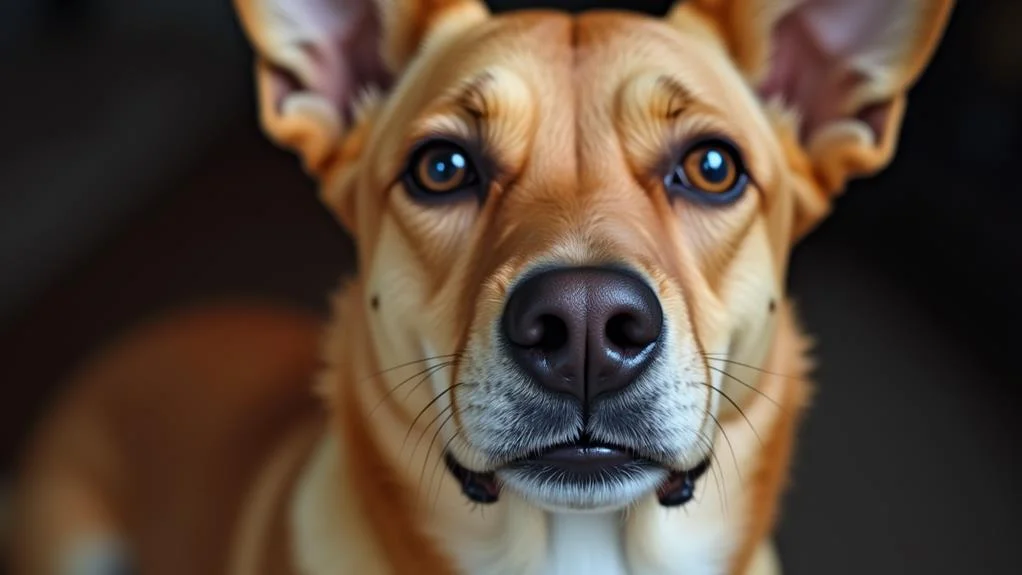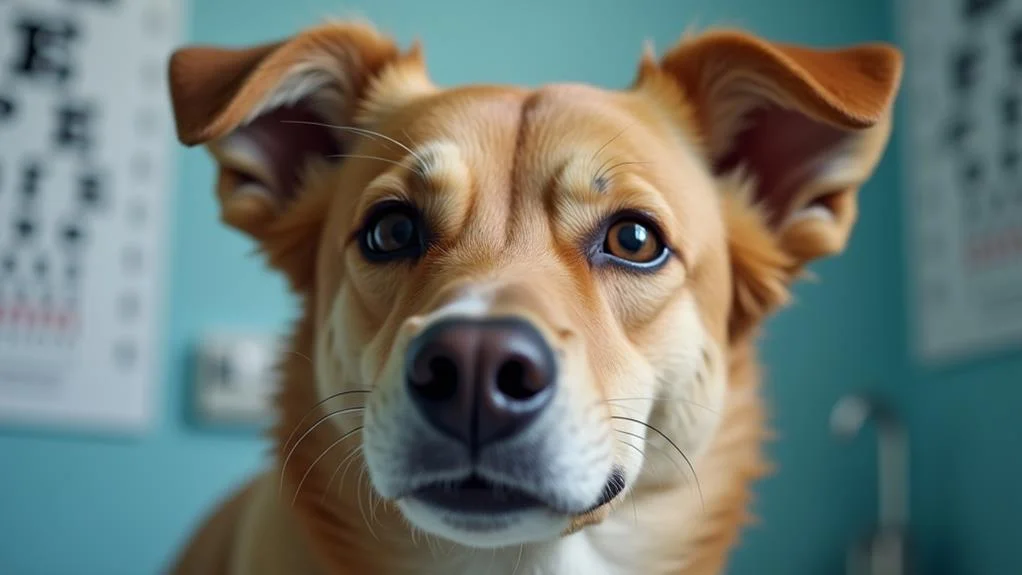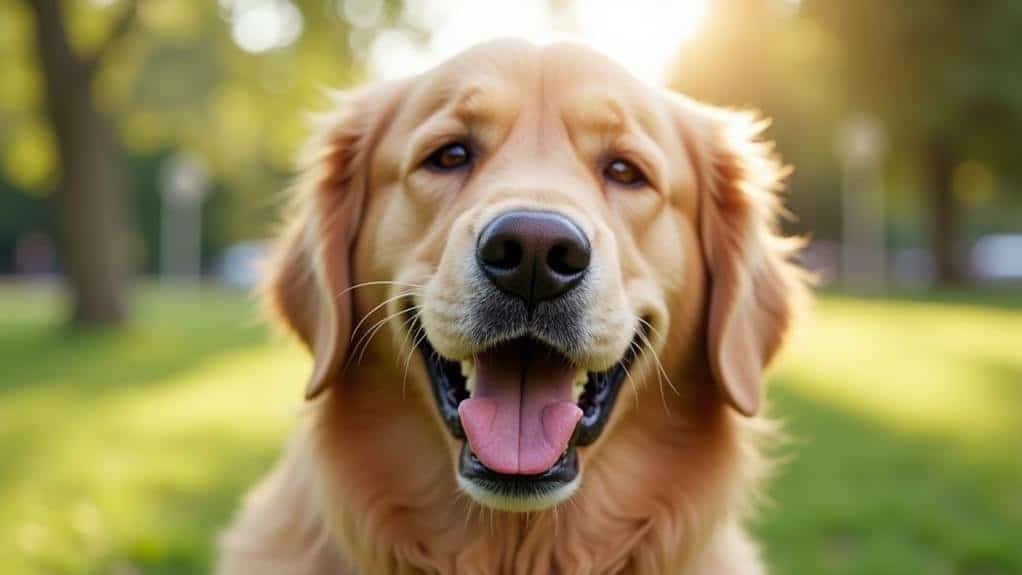Dogs wink for various reasons, often as a form of non-verbal communication.
When your furry friend winks at you, it’s usually a sign of happiness, contentment, or submission.
This cute behavior can strengthen your bond and may even be learned from human interactions.
Sometimes, dogs wink to seek attention or show friendliness in uncertain situations.
However, not all winks are positive; excessive winking might indicate eye irritation or health issues.
You can train your dog to wink on command, enhancing your communication.
Understanding Canine Winking Behavior

With a simple blink of one eye, dogs can convey a wealth of information. When you notice your furry friend giving you a dog wink, it’s more than just a cute gesture. Canine behavior experts recognize this as a form of communication that can express happiness, contentment, or even submission in social situations.
Dog winks often serve as a non-verbal cue to signal friendliness and non-aggression, especially during potentially tense interactions with other dogs or humans. This subtle form of body language helps strengthen social bonds and can be a learned behavior from observing human interactions.
While some winks are intentional, others may be reflexive responses to eye irritation or discomfort. It’s crucial to pay attention to your dog’s overall demeanor and the context in which the winking occurs. If you notice excessive winking, it could indicate underlying health issues, so don’t hesitate to seek veterinary advice.
You can even train your dog to wink on command using positive reinforcement techniques. By associating specific cues with the behavior, you’ll enhance your communication and deepen your connection with your canine companion.
Reasons Behind Dog Winking

You might be surprised to learn that there’s more to your dog’s winking than meets the eye. This seemingly simple behavior can convey a range of messages and emotions, making it an important part of canine communication.
When your dog winks, it’s often a sign of submission. They’re letting you or other dogs know they’re not a threat, helping to diffuse potential tension. It’s their way of saying, “I come in peace!”
In some cases, winking serves as a friendly gesture when your pup feels uncertain or threatened.
Dogs also use winking to seek attention or affection from their owners. If you’ve noticed your furry friend giving you a cheeky wink, they might be trying to engage you or prompt a response. It’s their clever way of saying, “Hey, look at me!”
However, not all winking is positive. Sometimes, it can indicate discomfort or health issues, such as eye irritation.
Pay attention to the context of your dog’s winking behavior, as it can represent various emotions ranging from happiness to unease.
Intentional Vs. Involuntary Winks

As a dog owner, distinguishing between intentional and involuntary winks is essential for understanding your pet’s communication.
Intentional winks in dogs are often characterized by exaggerated blinking and may be a learned behavior from social interactions with humans. These deliberate facial expressions can provide insight into your dog’s emotional well-being and serve as a form of non-verbal communication.
On the other hand, involuntary winks may occur due to eye irritation, discomfort, or underlying health issues. If you notice excessive blinking or winking, it could indicate conditions like blepharospasm or eye infections that require attention.
To determine whether your dog’s wink is intentional or involuntary, observe the context in which it occurs. Intentional winks are usually accompanied by other friendly body language, while involuntary winks may be accompanied by signs of discomfort or distress.
Training Dogs to Wink

Training your dog to wink can be a fun and rewarding experience for both you and your furry friend. This trick isn’t just adorable; it’s also a great way to enhance communication between you and your canine companion. Positive reinforcement is key to successfully teaching your dog this gesture.
To start, choose a quiet, distraction-free area for training. Begin by gently touching your dog’s whiskers or eyelid to encourage a wink. Immediately reward this behavior with treats or praise.
As your dog starts to understand, introduce a specific cue word or gesture to signal the desired action. Consistency is essential, so always use the same cue.
For faster results, consider using a clicker to mark the exact moment your dog winks. This technique helps your pet associate the action with the reward more quickly.
As training progresses, gradually reduce physical prompts and rely more on verbal cues.
Health Implications of Excessive Winking

While a dog’s occasional wink can be charming, excessive winking might signal underlying health issues that require attention. If you notice your furry friend winking more frequently than usual, it’s important to take into account potential causes and seek veterinary attention if needed.
Excessive winking can be a sign of eye infections, inflammation, or allergies that may be causing irritation or discomfort for your dog. In some cases, involuntary eyelid spasms, known as blepharospasm, can lead to frequent winking and may indicate pain in the affected eye.
Certain breeds are more prone to genetic conditions like entropion, where the eyelids flip inward, resulting in excessive blinking or winking due to irritation. If you observe your dog’s winking accompanied by redness, swelling, or discharge, it’s vital to consult a veterinarian promptly, as these symptoms may indicate a serious condition.
To guarantee your dog’s ocular health, schedule regular eye examinations with your vet. These check-ups can help prevent and address potential issues before they become more severe, safeguarding your pet’s overall comfort and well-being.
Responding to Your Dog’s Winks

Cherish those adorable canine winks! Responding to your dog’s winks can strengthen your relationship and deepen your bond. Dogs are known to interpret winking as a friendly, playful gesture, so when you wink back, you’re engaging in a special form of communication with your furry friend.
When you reciprocate your dog’s wink, you might notice them responding with tail wags or head tilts, reinforcing positive interactions. This simple act shows your attentiveness and affection, contributing to your dog’s emotional well-being.
To further encourage this charming behavior, consider using positive reinforcement techniques like treats or praise when your dog winks at you.
Pay attention to the context in which your dog winks, as it can provide valuable insights into their emotions and needs. By observing and responding appropriately, you’ll improve your ability to communicate with your canine companion.
Frequently Asked Questions
What Does It Mean When Your Dog Winks?
When your dog winks, it’s often a sign of affection or submission. They’re communicating non-threatening behavior, seeking attention, or expressing contentment. It can also indicate playfulness or mimic human behavior. Sometimes, it may signal eye discomfort.
Why Do Dogs Blink When You Talk to Them?
Your dog blinks when you talk to show they’re comfortable and trust you. It’s a relaxed body language signal. They’re also communicating non-aggression, reducing tension, and expressing affection. Blinking indicates your dog’s attentiveness to your words.
Why Do Dogs Hide Their Face in You?
Your dog hides its face in you to show affection and seek comfort. It’s a sign of trust and submission. They’re looking for closeness and reassurance from you, their trusted companion. It’s also a way to manage stress.
Why Do Dogs Put Their Head Down When Looking at You?
When your dog puts their head down while looking at you, they’re often showing submission or seeking affection. It’s a sign of trust and comfort. They might also be trying to calm a situation or invite interaction with you.
Conclusion
You’ve now uncovered the mystery behind your dog’s adorable winks! Whether it’s a sign of affection, submission, or simply a physical reflex, you’ll better understand your furry friend’s communication. Remember, while winking can be cute, excessive blinking might indicate health issues. If you’re concerned, consult your vet. Next time your pup gives you a wink, you’ll know exactly what they’re trying to say. Enjoy this special bond with your canine companion!

